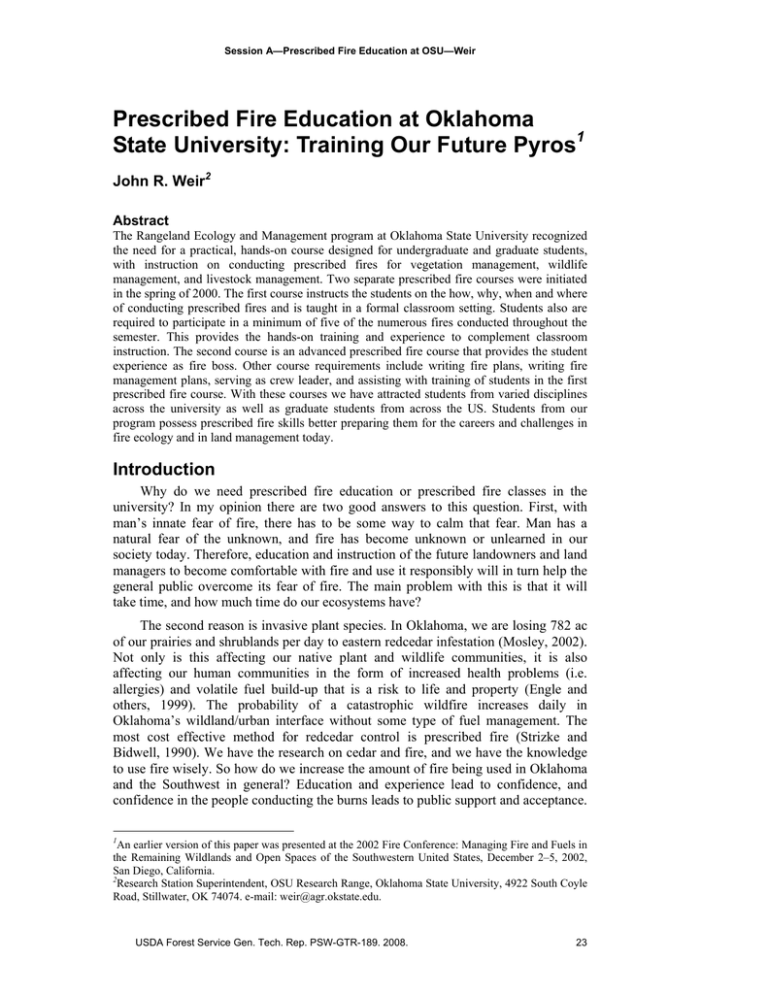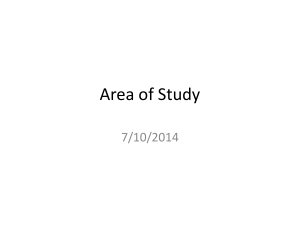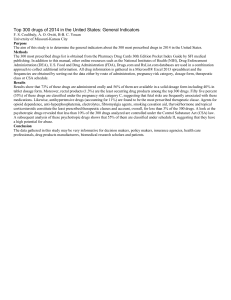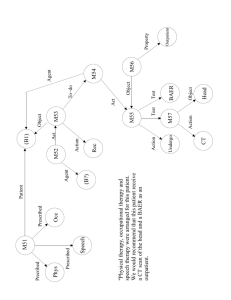Prescribed Fire Education at Oklahoma State University: Training Our Future Pyros
advertisement

Session A—Prescribed Fire Education at OSU—Weir Prescribed Fire Education at Oklahoma State University: Training Our Future Pyros1 John R. Weir2 Abstract The Rangeland Ecology and Management program at Oklahoma State University recognized the need for a practical, hands-on course designed for undergraduate and graduate students, with instruction on conducting prescribed fires for vegetation management, wildlife management, and livestock management. Two separate prescribed fire courses were initiated in the spring of 2000. The first course instructs the students on the how, why, when and where of conducting prescribed fires and is taught in a formal classroom setting. Students also are required to participate in a minimum of five of the numerous fires conducted throughout the semester. This provides the hands-on training and experience to complement classroom instruction. The second course is an advanced prescribed fire course that provides the student experience as fire boss. Other course requirements include writing fire plans, writing fire management plans, serving as crew leader, and assisting with training of students in the first prescribed fire course. With these courses we have attracted students from varied disciplines across the university as well as graduate students from across the US. Students from our program possess prescribed fire skills better preparing them for the careers and challenges in fire ecology and in land management today. Introduction Why do we need prescribed fire education or prescribed fire classes in the university? In my opinion there are two good answers to this question. First, with man’s innate fear of fire, there has to be some way to calm that fear. Man has a natural fear of the unknown, and fire has become unknown or unlearned in our society today. Therefore, education and instruction of the future landowners and land managers to become comfortable with fire and use it responsibly will in turn help the general public overcome its fear of fire. The main problem with this is that it will take time, and how much time do our ecosystems have? The second reason is invasive plant species. In Oklahoma, we are losing 782 ac of our prairies and shrublands per day to eastern redcedar infestation (Mosley, 2002). Not only is this affecting our native plant and wildlife communities, it is also affecting our human communities in the form of increased health problems (i.e. allergies) and volatile fuel build-up that is a risk to life and property (Engle and others, 1999). The probability of a catastrophic wildfire increases daily in Oklahoma’s wildland/urban interface without some type of fuel management. The most cost effective method for redcedar control is prescribed fire (Strizke and Bidwell, 1990). We have the research on cedar and fire, and we have the knowledge to use fire wisely. So how do we increase the amount of fire being used in Oklahoma and the Southwest in general? Education and experience lead to confidence, and confidence in the people conducting the burns leads to public support and acceptance. 1 An earlier version of this paper was presented at the 2002 Fire Conference: Managing Fire and Fuels in the Remaining Wildlands and Open Spaces of the Southwestern United States, December 2–5, 2002, San Diego, California. 2 Research Station Superintendent, OSU Research Range, Oklahoma State University, 4922 South Coyle Road, Stillwater, OK 74074. e-mail: weir@agr.okstate.edu. USDA Forest Service Gen. Tech. Rep. PSW-GTR-189. 2008. 23 Session A—Prescribed Fire Education at OSU—Weir Education and experience is the only way we will increase the amount of fire on the ground and smoke in the air. We have to train our future landowners, land managers and policy makers that prescribed fire can be used safely and is the most effective and economically viable way to maintain our natural ecosystems. Public land states typically have several agencies that try to use fire and spread the word about fire. They have budgets for training, education and public service programs. In the private-land states, universities, through research and extension programs, are the main source for prescribed fire education. Mark Twain once wrote “All schools and all colleges have two great functions: to confer and to conceal valuable knowledge.” In the past we may have been guilty of the latter part of what Mr. Twain said, but now we are trying not to conceal anything about prescribed fire, but rather, get the word out. Oklahoma, Texas, and New Mexico, as well as the rest of the Southwest and Great Plains, are in need of wise fire management, especially on privately owned wildands. Most of this region is made up of private lands or non-federal ownership. Oklahoma’s land area is over 90 percent private land ownership, with the rest being urban areas, Indian lands, state lands and US Forest Service lands. Private landowners and non-federal land managers generally are unwilling to accommodate the federal bureaucracy to attend Federal prescribed fire schools and vice versa. Federal agencies have little influence within a state that is predominately private lands other than to provide technical assistance, incentives, and cost share programs to the landowners. So how do you educate the future managers and put fire on the ground? Educate them before you hire them. Fire Courses We have had students helping us for years on our research burns. They have always asked for more formal training and more prescribed burns on which to participate. In response, we developed a prescribed fire course in 1999, and in the spring of 2000 we enrolled 21 students in the Prescribed Fire course and five students in the Advanced Prescribed Fire course. Since that time, we have instructed 65 students in Prescribed Fire and 16 in the Advanced Prescribed Fire. The students are mainly undergraduate seniors and graduate students in Rangeland Ecology and Management, Wildlife, Forestry, Animal Science, Environmental Sciences, and Political Science. The course fills up rapidly every spring with many students waiting a year to enroll. Prescribed Fire (RLEM 4983) The Prescribed Fire class is limited to 20 students a semester. Lecture can accommodate several hundred people, but when it comes to conducting a fire you can have too many students on site, so this is the reason the course is limited to 20. Normally half to three-quarters of the class show up at each burn. This is a manageable size, and each student can actually participate in a task and not stand around being bored or causing a safety hazard. Safety, history of prescribed fire, reasons why we burn, and prescribed fire laws and policies are covered in lecture. In addition, prescribed fire weather, sources of forecasts, appropriate fire prescriptions for the vegetation regions of Oklahoma, burn techniques and proper ignition devices are covered. We review the basics of fire plans and what should be included in every plan and step-by-step methods for smoke 24 USDA Forest Service Gen. Tech. Rep. PSW-GTR-189. 2008. Session A—Prescribed Fire Education at OSU—Weir management. Lectures on prescribed fire economics and the development of prescribed fire cooperatives are also included. Quizzes and tests are given over these subjects throughout the semester to account for 40 percent of the class grade. Each student is required to attend a field session in Prescribed Fire Equipment and Spotfire Training, a five to six hour lab, in which each piece of equipment we use on prescribed fires is reviewed for safe operation and utility. We also instruct on how spotfires occur and how to fight them safely and effectively. The students are then given a short test over this subject matter. Following this, we set a series of fires so the students can operate all equipment and learn the effectiveness, and the suitability of each piece of equipment. Simulated spot fires are ignited for the students to extinguish and to demonstrate safe suppression and mop-up techniques. We finish by burning a small unit to bring all of these techniques together. This training counts 15 percent toward the course grade and is required before a student attends any burns. The students are also required to go on five burns for 25 percent of the course grade. This requirement allows the students to really learn about prescribed fire. We normally conduct 15 to 20 burns per spring. A few burns count as two credits, depending upon size and complexity. The burns units range in size from seven acres to 900 acres. Students who return the next day for mop-up of a burn will also get credit for a burn. If we arrive at a burn and the decision is made not to burn due to weather conditions, the students still get credit for a burn. Learning when not to burn is an important part of the learning experience. We make sure each student uses all the equipment and performs all the tasks throughout the semester. We have several experienced research technicians who assist with each burn and provide individual instruction to the students. Some students are satisfied with just participating in five burns, while several participate in several burns. Each year we have one or two students who attend every burn conducted. For each burn over the required five, a student receives one bonus point toward the final grade. At the end of the year “The Pyro of the Year” is awarded to the student or students who have participated on the most burns that year. The final project the students must complete is a fire plan. The students are given a burn unit and an outline of requirements for a fire plan. The students are required to make-up a fire plan, complete with ignition plans, escaped fire contingency plans, smoke management plan and crew assignments as 20 percent of the course grade. Advanced Prescribed Fire (RLEM 5993) We offered Advanced Prescribed Fire for those students wanting to extend their fire experience and take a leadership role in conducting fires. This course does not concentrate as much on formal classroom lectures as it does on learning by experience. Requirements for this course are completion of Prescribed Fire RLEM 4983 and consent of the instructor. One of the first class requirements is to assist with teaching the Prescribed Fire Equipment and Spotfire Training to the semester’s Prescribed Fire RLEM 4983 students. This helps the student build confidence in their ability to lead and assign people to tasks, as well as, learn how to work with people who do not yet understand the concepts of prescribed fire. This requirement counts toward 15 percent of the course grade. The student is also required to be a crew leader on at least one burn during the semester. The student is in charge of an ignition and suppression crew. The student USDA Forest Service Gen. Tech. Rep. PSW-GTR-189. 2008. 25 Session A—Prescribed Fire Education at OSU—Weir assigns crew members to the assigned tasks, follows the ignition plan, oversees the safety of each crewmember, and handles any problems that may arise. This counts as 15 percent of the grade. The main part of this course and 35 percent of the grade is the fire plan and serving as fire boss. Each student is assigned a burn unit the first week of class for which they write a detailed burn plan and serve as fire boss. The student is required to make sure the weather is acceptable for that day and for notifying adjoining landowners, fire departments and crewmembers and making sure the equipment is ready. The student then reviews the ignition plan and assignments with crew leaders and crewmembers. The burn is that student’s from the time it is ignited until mop-up is complete. It is interesting to watch how nervous and quiet the students become when they are in charge. Most students tell me it is not as much fun being in charge as it is being just a crewmember. This is part of the experience gained in being fire boss, and this will enable the students to make better decisions in the future. Two case studies are assigned during the semester. These case studies involve a nearby management area. We have used private ranches, recreation areas, and a golf course that encompassed considerable wildland area. We meet with the manager of the area and students ask questions about management goals and objectives. The student then writes a prescribed fire plan, public relations plan, fuel management plan, budget for equipment purchases, and a crew-training plan for each area. These case studies are 40 percent of the grade for the semester. Results from Courses Students from our program possess prescribed fire skills better preparing them for careers in fire ecology and in land management. The students not only have more formal classroom training than most Federal and State agencies require, they also have considerable actual prescribed fire experience when they finish. This experience would take several years to acquire on most jobs. With the condition most of our lands are in now, we cannot afford to wait any longer. Many different employers are hiring the students who have completed these courses and many more prescribed fire jobs appear on the horizon (table 1). Table 1—Employers of former students who have taken courses in prescribed fire at OSU and who are applying skills acquired in the courses. Private The Nature Conservancy Red Buffalo, LLC Bluestem, LLC-Turner Ranches, Inc. Private Ranch and Wildlife Managers 26 Universities and State Agencies Rangeland Ecology & Management, OSU Oklahoma Dept. of Wildlife Conservation Texas Parks & Wildlife Texas Division of Forestry Missouri Department of Conservation Federal Agencies US Fish & Wildlife US Forest Service USDA-Agricultural Research Service USDA-Natural Resource Conservation Service Bureau of Land Management Bureau of Indian Affairs US Army Corp of Engineers USDA Forest Service Gen. Tech. Rep. PSW-GTR-189. 2008. Session A—Prescribed Fire Education at OSU—Weir References Engle, D.M.; Bidwell, T.G.; Moseley, M.E. 1999. Invasion of Oklahoma rangelands and forests by eastern redcedar and ashe juniper. Circular E-947. Oklahoma Cooperative Extension Service, Oklahoma State University. Stillwater, OK; 10 p. Mosley, M. 2002. It may rain on the plains, but is there a change on the range? Presentation. Oklahoma Section Society for Range Management Annual Meeting, Ardmore, OK. Strizke, J.F.; Bidwell, T.G. 1990. Eastern redcedar and its control. Fact Sheet F-2850. Oklahoma Cooperative Extension Service, Oklahoma State University, Stillwater, OK; 4 p. USDA Forest Service Gen. Tech. Rep. PSW-GTR-189. 2008. 27 This page intentionally left blank. 28 USDA Forest Service Gen. Tech. Rep. PSW-GTR-189. 2008.






